Haoliang Sun
CausalCOMRL: Context-Based Offline Meta-Reinforcement Learning with Causal Representation
Feb 03, 2025



Abstract:Context-based offline meta-reinforcement learning (OMRL) methods have achieved appealing success by leveraging pre-collected offline datasets to develop task representations that guide policy learning. However, current context-based OMRL methods often introduce spurious correlations, where task components are incorrectly correlated due to confounders. These correlations can degrade policy performance when the confounders in the test task differ from those in the training task. To address this problem, we propose CausalCOMRL, a context-based OMRL method that integrates causal representation learning. This approach uncovers causal relationships among the task components and incorporates the causal relationships into task representations, enhancing the generalizability of RL agents. We further improve the distinction of task representations from different tasks by using mutual information optimization and contrastive learning. Utilizing these causal task representations, we employ SAC to optimize policies on meta-RL benchmarks. Experimental results show that CausalCOMRL achieves better performance than other methods on most benchmarks.
Towards Macro-AUC oriented Imbalanced Multi-Label Continual Learning
Dec 24, 2024



Abstract:In Continual Learning (CL), while existing work primarily focuses on the multi-class classification task, there has been limited research on Multi-Label Learning (MLL). In practice, MLL datasets are often class-imbalanced, making it inherently challenging, a problem that is even more acute in CL. Due to its sensitivity to imbalance, Macro-AUC is an appropriate and widely used measure in MLL. However, there is no research to optimize Macro-AUC in MLCL specifically. To fill this gap, in this paper, we propose a new memory replay-based method to tackle the imbalance issue for Macro-AUC-oriented MLCL. Specifically, inspired by recent theory work, we propose a new Reweighted Label-Distribution-Aware Margin (RLDAM) loss. Furthermore, to be compatible with the RLDAM loss, a new memory-updating strategy named Weight Retain Updating (WRU) is proposed to maintain the numbers of positive and negative instances of the original dataset in memory. Theoretically, we provide superior generalization analyses of the RLDAM-based algorithm in terms of Macro-AUC, separately in batch MLL and MLCL settings. This is the first work to offer theoretical generalization analyses in MLCL to our knowledge. Finally, a series of experimental results illustrate the effectiveness of our method over several baselines. Our codes are available at https://github.com/ML-Group-SDU/Macro-AUC-CL.
Diverse Teacher-Students for Deep Safe Semi-Supervised Learning under Class Mismatch
May 25, 2024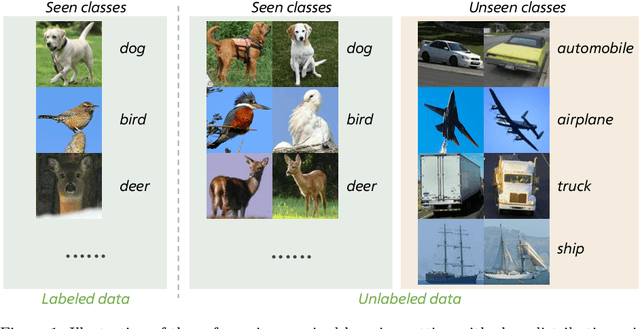
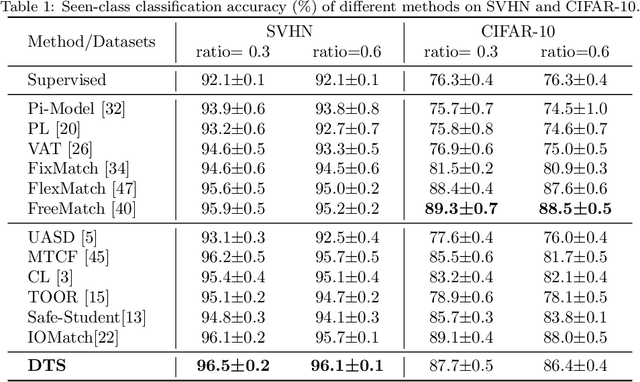

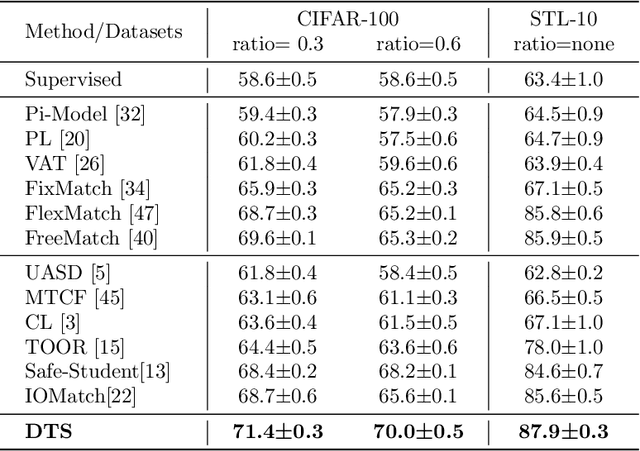
Abstract:Semi-supervised learning can significantly boost model performance by leveraging unlabeled data, particularly when labeled data is scarce. However, real-world unlabeled data often contain unseen-class samples, which can hinder the classification of seen classes. To address this issue, mainstream safe SSL methods suggest detecting and discarding unseen-class samples from unlabeled data. Nevertheless, these methods typically employ a single-model strategy to simultaneously tackle both the classification of seen classes and the detection of unseen classes. Our research indicates that such an approach may lead to conflicts during training, resulting in suboptimal model optimization. Inspired by this, we introduce a novel framework named Diverse Teacher-Students (\textbf{DTS}), which uniquely utilizes dual teacher-student models to individually and effectively handle these two tasks. DTS employs a novel uncertainty score to softly separate unseen-class and seen-class data from the unlabeled set, and intelligently creates an additional ($K$+1)-th class supervisory signal for training. By training both teacher-student models with all unlabeled samples, DTS can enhance the classification of seen classes while simultaneously improving the detection of unseen classes. Comprehensive experiments demonstrate that DTS surpasses baseline methods across a variety of datasets and configurations. Our code and models can be publicly accessible on the link https://github.com/Zhanlo/DTS.
Improving Generalization in Meta-Learning via Meta-Gradient Augmentation
Jun 14, 2023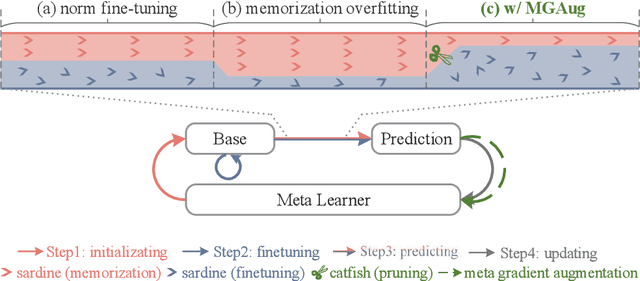

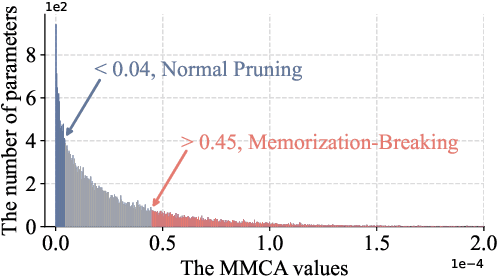

Abstract:Meta-learning methods typically follow a two-loop framework, where each loop potentially suffers from notorious overfitting, hindering rapid adaptation and generalization to new tasks. Existing schemes solve it by enhancing the mutual-exclusivity or diversity of training samples, but these data manipulation strategies are data-dependent and insufficiently flexible. This work alleviates overfitting in meta-learning from the perspective of gradient regularization and proposes a data-independent \textbf{M}eta-\textbf{G}radient \textbf{Aug}mentation (\textbf{MGAug}) method. The key idea is to first break the rote memories by network pruning to address memorization overfitting in the inner loop, and then the gradients of pruned sub-networks naturally form the high-quality augmentation of the meta-gradient to alleviate learner overfitting in the outer loop. Specifically, we explore three pruning strategies, including \textit{random width pruning}, \textit{random parameter pruning}, and a newly proposed \textit{catfish pruning} that measures a Meta-Memorization Carrying Amount (MMCA) score for each parameter and prunes high-score ones to break rote memories as much as possible. The proposed MGAug is theoretically guaranteed by the generalization bound from the PAC-Bayes framework. In addition, we extend a lightweight version, called MGAug-MaxUp, as a trade-off between performance gains and resource overhead. Extensive experiments on multiple few-shot learning benchmarks validate MGAug's effectiveness and significant improvement over various meta-baselines. The code is publicly available at \url{https://github.com/xxLifeLover/Meta-Gradient-Augmentation}.
MetaViewer: Towards A Unified Multi-View Representation
Mar 11, 2023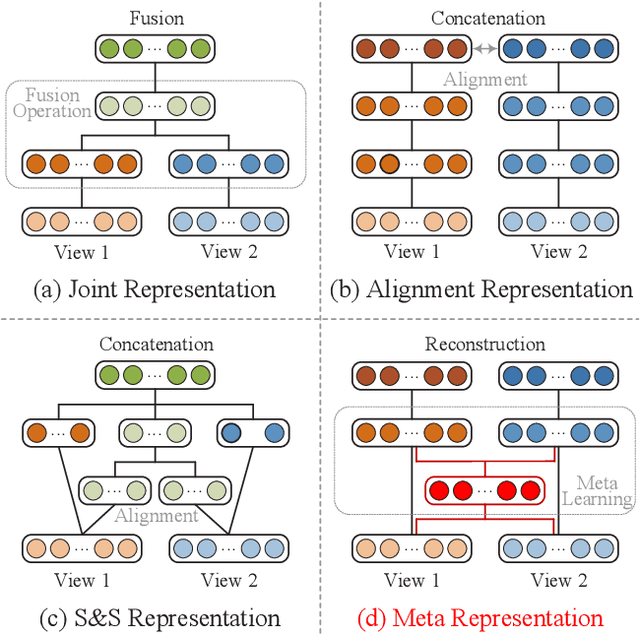

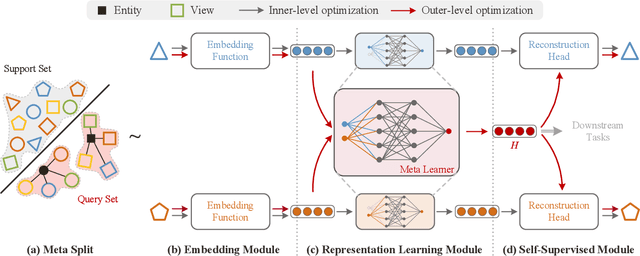
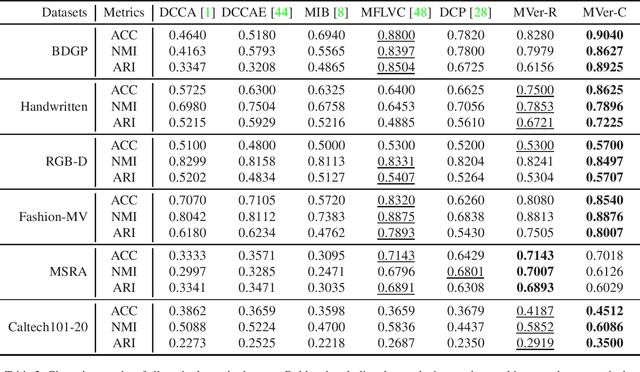
Abstract:Existing multi-view representation learning methods typically follow a specific-to-uniform pipeline, extracting latent features from each view and then fusing or aligning them to obtain the unified object representation. However, the manually pre-specify fusion functions and view-private redundant information mixed in features potentially degrade the quality of the derived representation. To overcome them, we propose a novel bi-level-optimization-based multi-view learning framework, where the representation is learned in a uniform-to-specific manner. Specifically, we train a meta-learner, namely MetaViewer, to learn fusion and model the view-shared meta representation in outer-level optimization. Start with this meta representation, view-specific base-learners are then required to rapidly reconstruct the corresponding view in inner-level. MetaViewer eventually updates by observing reconstruction processes from uniform to specific over all views, and learns an optimal fusion scheme that separates and filters out view-private information. Extensive experimental results in downstream tasks such as classification and clustering demonstrate the effectiveness of our method.
Fine-Grained Classification with Noisy Labels
Mar 04, 2023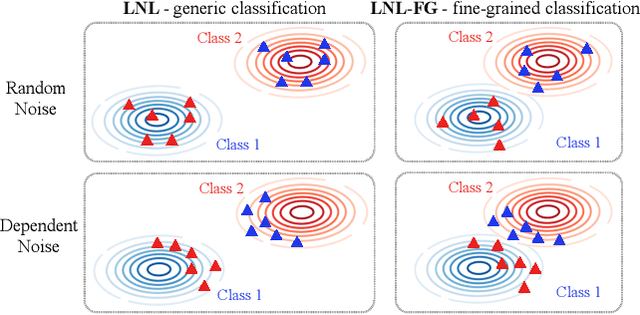
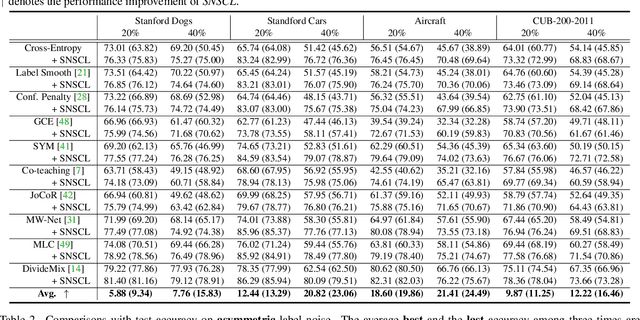

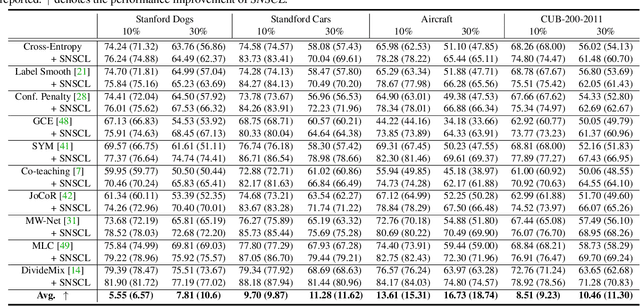
Abstract:Learning with noisy labels (LNL) aims to ensure model generalization given a label-corrupted training set. In this work, we investigate a rarely studied scenario of LNL on fine-grained datasets (LNL-FG), which is more practical and challenging as large inter-class ambiguities among fine-grained classes cause more noisy labels. We empirically show that existing methods that work well for LNL fail to achieve satisfying performance for LNL-FG, arising the practical need of effective solutions for LNL-FG. To this end, we propose a novel framework called stochastic noise-tolerated supervised contrastive learning (SNSCL) that confronts label noise by encouraging distinguishable representation. Specifically, we design a noise-tolerated supervised contrastive learning loss that incorporates a weight-aware mechanism for noisy label correction and selectively updating momentum queue lists. By this mechanism, we mitigate the effects of noisy anchors and avoid inserting noisy labels into the momentum-updated queue. Besides, to avoid manually-defined augmentation strategies in contrastive learning, we propose an efficient stochastic module that samples feature embeddings from a generated distribution, which can also enhance the representation ability of deep models. SNSCL is general and compatible with prevailing robust LNL strategies to improve their performance for LNL-FG. Extensive experiments demonstrate the effectiveness of SNSCL.
Self-Filtering: A Noise-Aware Sample Selection for Label Noise with Confidence Penalization
Aug 24, 2022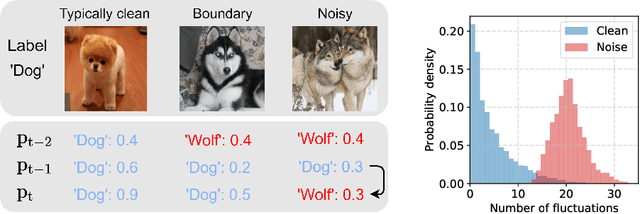
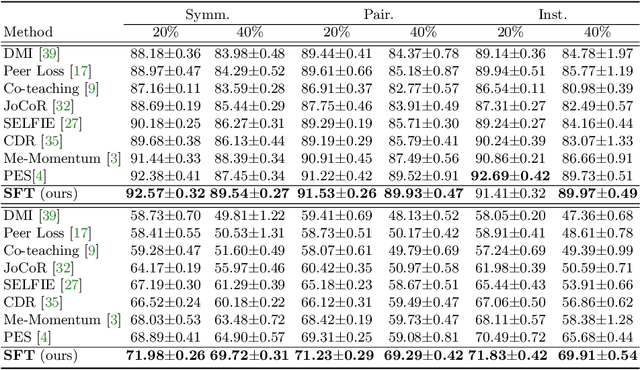


Abstract:Sample selection is an effective strategy to mitigate the effect of label noise in robust learning. Typical strategies commonly apply the small-loss criterion to identify clean samples. However, those samples lying around the decision boundary with large losses usually entangle with noisy examples, which would be discarded with this criterion, leading to the heavy degeneration of the generalization performance. In this paper, we propose a novel selection strategy, \textbf{S}elf-\textbf{F}il\textbf{t}ering (SFT), that utilizes the fluctuation of noisy examples in historical predictions to filter them, which can avoid the selection bias of the small-loss criterion for the boundary examples. Specifically, we introduce a memory bank module that stores the historical predictions of each example and dynamically updates to support the selection for the subsequent learning iteration. Besides, to reduce the accumulated error of the sample selection bias of SFT, we devise a regularization term to penalize the confident output distribution. By increasing the weight of the misclassified categories with this term, the loss function is robust to label noise in mild conditions. We conduct extensive experiments on three benchmarks with variant noise types and achieve the new state-of-the-art. Ablation studies and further analysis verify the virtue of SFT for sample selection in robust learning.
* 14 pages
Learning to Rectify for Robust Learning with Noisy Labels
Nov 08, 2021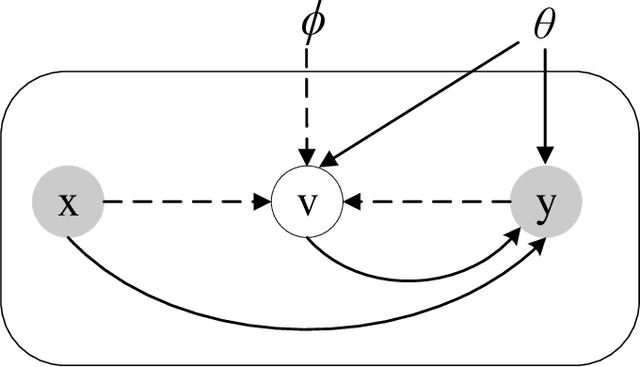

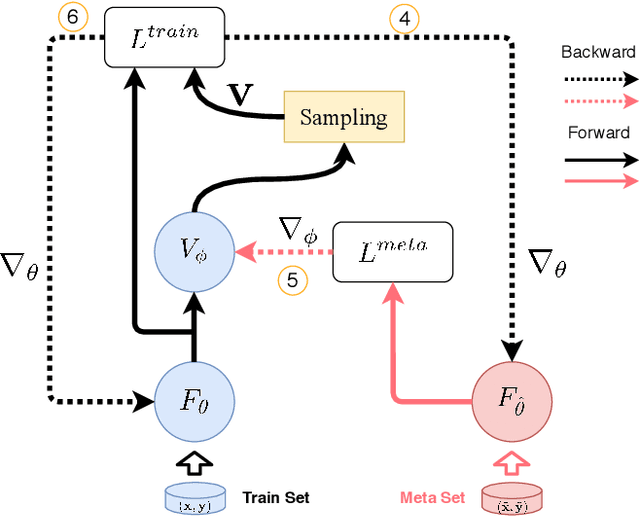
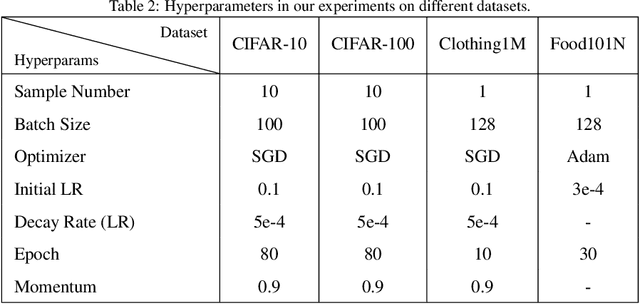
Abstract:Label noise significantly degrades the generalization ability of deep models in applications. Effective strategies and approaches, \textit{e.g.} re-weighting, or loss correction, are designed to alleviate the negative impact of label noise when training a neural network. Those existing works usually rely on the pre-specified architecture and manually tuning the additional hyper-parameters. In this paper, we propose warped probabilistic inference (WarPI) to achieve adaptively rectifying the training procedure for the classification network within the meta-learning scenario. In contrast to the deterministic models, WarPI is formulated as a hierarchical probabilistic model by learning an amortization meta-network, which can resolve sample ambiguity and be therefore more robust to serious label noise. Unlike the existing approximated weighting function of directly generating weight values from losses, our meta-network is learned to estimate a rectifying vector from the input of the logits and labels, which has the capability of leveraging sufficient information lying in them. This provides an effective way to rectify the learning procedure for the classification network, demonstrating a significant improvement of the generalization ability. Besides, modeling the rectifying vector as a latent variable and learning the meta-network can be seamlessly integrated into the SGD optimization of the classification network. We evaluate WarPI on four benchmarks of robust learning with noisy labels and achieve the new state-of-the-art under variant noise types. Extensive study and analysis also demonstrate the effectiveness of our model.
Learning Transferable Parameters for Unsupervised Domain Adaptation
Aug 13, 2021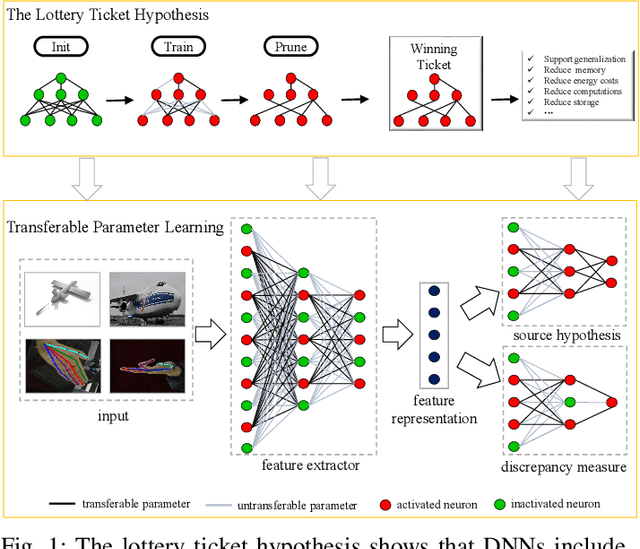
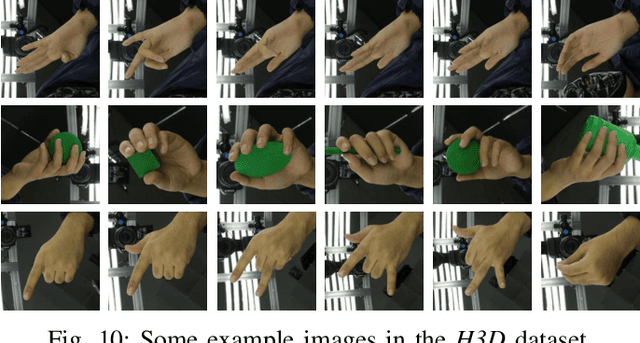
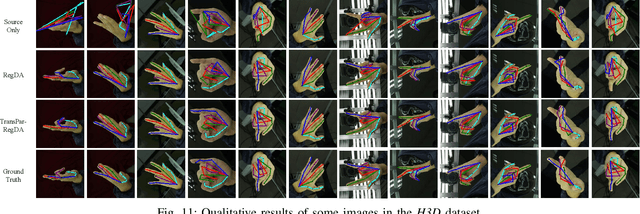
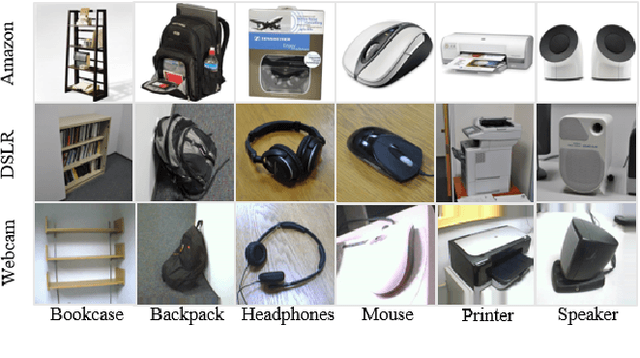
Abstract:Unsupervised domain adaptation (UDA) enables a learning machine to adapt from a labeled source domain to an unlabeled domain under the distribution shift. Thanks to the strong representation ability of deep neural networks, recent remarkable achievements in UDA resort to learning domain-invariant features. Intuitively, the hope is that a good feature representation, together with the hypothesis learned from the source domain, can generalize well to the target domain. However, the learning processes of domain-invariant features and source hypothesis inevitably involve domain-specific information that would degrade the generalizability of UDA models on the target domain. In this paper, motivated by the lottery ticket hypothesis that only partial parameters are essential for generalization, we find that only partial parameters are essential for learning domain-invariant information and generalizing well in UDA. Such parameters are termed transferable parameters. In contrast, the other parameters tend to fit domain-specific details and often fail to generalize, which we term as untransferable parameters. Driven by this insight, we propose Transferable Parameter Learning (TransPar) to reduce the side effect brought by domain-specific information in the learning process and thus enhance the memorization of domain-invariant information. Specifically, according to the distribution discrepancy degree, we divide all parameters into transferable and untransferable ones in each training iteration. We then perform separate updates rules for the two types of parameters. Extensive experiments on image classification and regression tasks (keypoint detection) show that TransPar outperforms prior arts by non-trivial margins. Moreover, experiments demonstrate that TransPar can be integrated into the most popular deep UDA networks and be easily extended to handle any data distribution shift scenarios.
Attentional Prototype Inference for Few-Shot Semantic Segmentation
May 14, 2021
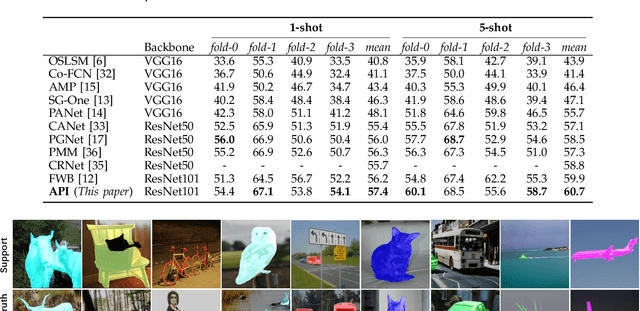
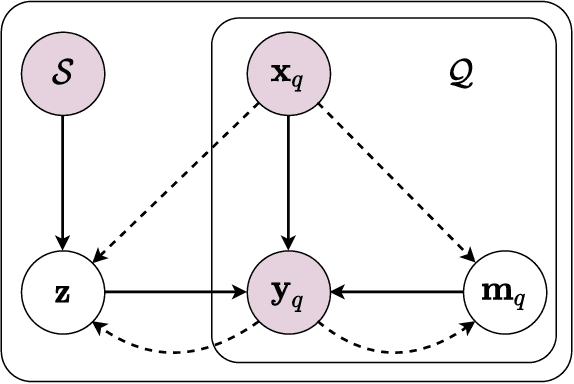
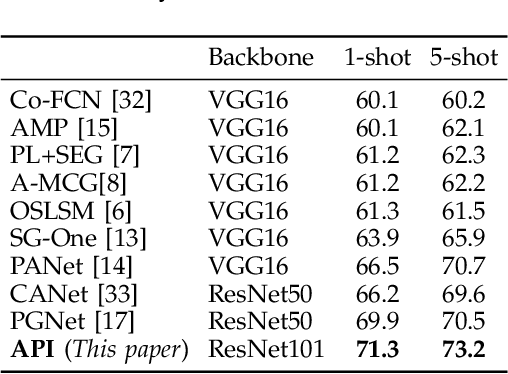
Abstract:This paper aims to address few-shot semantic segmentation. While existing prototype-based methods have achieved considerable success, they suffer from uncertainty and ambiguity caused by limited labelled examples. In this work, we propose attentional prototype inference (API), a probabilistic latent variable framework for few-shot semantic segmentation. We define a global latent variable to represent the prototype of each object category, which we model as a probabilistic distribution. The probabilistic modeling of the prototype enhances the model's generalization ability by handling the inherent uncertainty caused by limited data and intra-class variations of objects. To further enhance the model, we introduce a local latent variable to represent the attention map of each query image, which enables the model to attend to foreground objects while suppressing background. The optimization of the proposed model is formulated as a variational Bayesian inference problem, which is established by amortized inference networks.We conduct extensive experiments on three benchmarks, where our proposal obtains at least competitive and often better performance than state-of-the-art methods. We also provide comprehensive analyses and ablation studies to gain insight into the effectiveness of our method for few-shot semantic segmentation.
 Add to Chrome
Add to Chrome Add to Firefox
Add to Firefox Add to Edge
Add to Edge